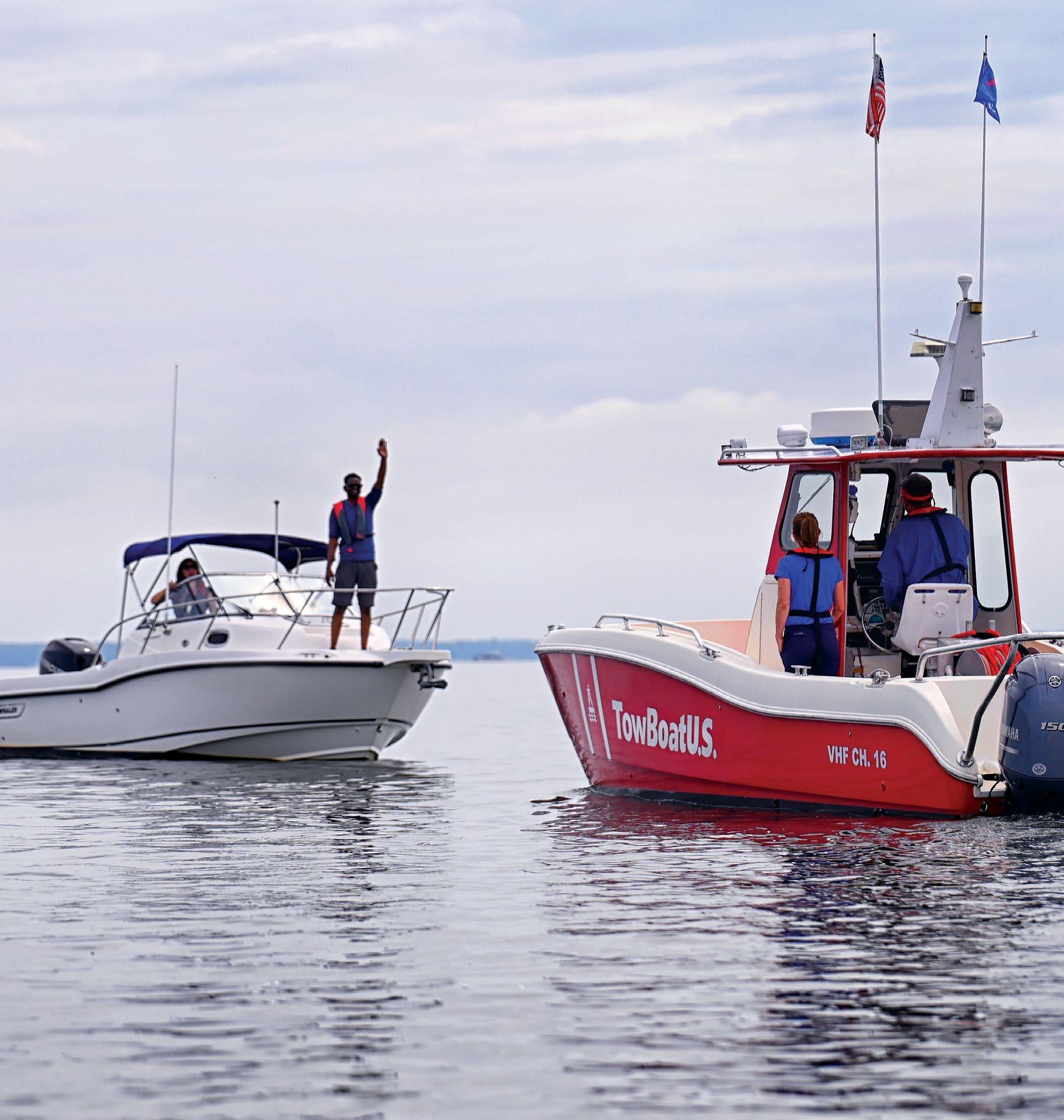
4 minute read
Great Gear
WHEN SEEING RED IS A GOOD THING
Lake Michigan
UNLIMITED TOWING
$85 *
Don’t get mad, get an Unlimited Towing Membership from BoatU.S.
That way breakdowns, running out of fuel and soft ungroundings won’t throw you for a loop. For a year of worry-free boating, get towing before you get going.
GET THE APP – IT’S THE FASTEST WAY TO GET A TOW
Can You See Me Now? The ABCs of visual distress signals.
Electronic flares
While Coast Guard approval for nonpyrotechnic visual distress signals is currently limited to the distress flag and electronic SOS distress light, that doesn’t mean true electronic flares are not being developed. Products such as the MK 3 LED flare by ODEO and the rescueME EDF1 electronic distress flare will hopefully see approval as an alternative to pyrotechnic flares at some point. Although not currently U.S. Coast Guard-approved, both are effective, reusable, long lasting and, in my opinion, are more recognizable as a visible distress signal than an SOS distress light. Safety-conscious mariners should not hesitate to carry them in addition to the required, currently approved visual distress signals; there are no restrictions for carrying alternative electronic signal devices, and Coast Guard approval is not required to use them.
Despite the importance of modern visual distress signals such as EPIRBs and Digital Selective Calling (DSC), old-school options remain both relevant and are the only type of distress signals boaters are required by law to have onboard. Here’s a look at the types of approved visual distress signals available, along with the pros and cons you should know about each.
Visual distress signal basics: Visual distress signals fall into two broad categories: Pyrotechnic and non-pyrotechnic devices. These can be further divided into day and night use, although some are suitable for both.
Examples of pyrotechnic devices include red flares (hand-held or aerial), orange smoke flares and canisters. Non-pyrotechnic signals include any other type of visual distress signal, from signal mirrors to distress flags.
In order to satisfy the minimum federally mandated requirements, each signaling device must be U.S. Coast Guard or SOLAS (Safety of Life at Sea) approved, with any combination of pyrotechnic and/or non-pyrotechnic distress signals totaling three for day use and three for night use.
Meeting the minimum requirements, however, does not mean you’re carrying all the signaling devices you’ll want onboard. Like winning lottery numbers, you can’t have too many emergency signaling devices when the need arises. In my opinion every vessel should carry at least double what’s required by law — more when coastal or offshore cruising.
Pyrotechnic signals: Flares are relatively inexpensive and a popular choice with boat owners, who typically meet U.S. Coast Guard carriage requirements with red hand-held or aerial flares suitable for day and night use. SOLAS flares are approved by the International Maritime Organization for use on the high seas. While more expensive, they typically exceed U.S. Coast Guard standards for luminosity and burn time. Many recreational boaters choose SOLAS devices for the added margin of safety they provide. If you choose the less expensive U.S. Coast Guard-approved flares, do yourself a favor and buy additional spares with the money saved.
Flares are required by law to have a 42-month service life and have their expiration date stamped on them. If you’re a typical boat owner, you probably have a number of expired flares onboard for “back-ups” (everyone hates throwing away things they had to buy, but didn’t use). While they can remain operational years past their expiration date, the chemicals used in flares will deteriorate over time, so don’t be surprised if your expired back-ups are harder to light, have shorter burn times, decreased altitudes or simply fail to work when the time comes. For reliable back-ups, carry spares that are within their expiration date.
Flares make excellent distress signals, but they do have drawbacks. They can only be used once and can cause personal injury and property damage if not handled properly. Flares generate molten slag while burning, so hold them well overboard when firing or lighting them and during use.
Aerial flares and launchers should be treated with the same respect as firearms. Some states may even consider the pistol launcher for meteors and parachute flares to be a firearm, so ask about local laws when purchasing.
Non-pyrotechnic signals: The only U.S. Coast Guard-approved, non-pyrotechnic visual distress signals are the Orange Distress Flag and the Electric Distress or SOS light.
The distress flag is a day signal consisting of a black square and ball on an orange background. Size-wise, it has to be at least 3 feet by 3 feet and marked as meeting Coast Guard requirements in 46 CFR 160.072. While flares are considered more effective by many, distress flags have the advantage of working without your intervention for as long as they are displayed. You can also significantly increase their visibility by attaching them to a paddle or boat hook and waving them about or by flying them from the highest point on your vessel.
Electric distress lights are for night use only. They must automatically flash the international SOS distress signal (three short flashes, three long flashes, three short flashes) and be labeled as meeting Coast Guard requirements stated 46 CFR 161.013. Ordinary flashlights are not acceptable substitutes for an electric distress light, as they must be manually flashed and are normally not bright enough.
Modern versions of the electronic distress light include the Orion Electronic SOS Distress Beacon Kit and the Sirius Signal C-1002 SOS distress light with day signal flag. Two things to note about both of these products. First, they are not “electronic flares;” despite some advertising claims










